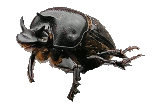
Main index
Introduction
Natives
Exotics
Projects
Life-cycle
Trapping
Identification
References
Contacts
info@dunghillpress.com
The first exotic dung beetles were introduced into Tasmania in the early 1980s. Doug and Dawn Kershaw, dairy farmers from Tulendeena (NE Tasmania), received their first batch of O. binodis in 1981.

Doug and Dawn eventually gave away well over 1 million beetles to landholders from across the State. Furthermore, Doug initiated many Landcare grants to introduce new species into the State, and undertook several state-wide surveys to determine the success of previous releases.
Doug was honoured for this work with the Order of Australia Medal.
A total of thirteen exotic dung beetle species have been introduced into Tasmania since 1972, however only five species have successfully established; (Geotrupes spiniger, Bubas bison, Onthophagus binodis, Onthophagus taurus and Euoniticellus fulvus). Also introduced (accidentally via the first settlers) was the dung âdwellerâ, Aphodius fimaterius.
Dung beetles can be classified as either winter active (G. spiniger and B. bison, both of which fly at dusk and dawn and have life-cycles of ½ year or more) or summer active (with life-cycles of around 30 days which fly during warm sunny days).
Unverified releases
Those species unverified (not found during several on-ground surveys) and the areas in which they were released include;- Euoniticellus africanus; Cressy, Perth and Yolla
- Euoniticellus intermedius; Pyengana, Waterhouse, Bridport, Moltema and Elliott
- Euoniticellus pallipes; Swansea, Waterhouse, Bridport, Tullendeena, Westbury and Elliott
- Onitis alexis; Bridport, Waterhouse, Karoola, Pipers River, Cressy, Kindred, and Paradise
- Onitis aygulus; Sheffield
- Onitis caffer; Tullendeena
- Onthophagus gazelle; Kettering, Oatlands, Longford, Pipers River, Pyengana, Waterhouse, Moltema, Montagu
- Onitis pecuarius; Pyengana, Waterhouse, Tullendeena, Scottsdale, Pipers River, Bridport, Karoola, Paradise, Kindred
Possible causes of dung beetle failures
- Research has shown that many of the drenches used on livestock are detrimental to dung beetles, particularly when the beetle is in the larvae/pupae stage. This is especially evident on properties with horses.
- Chooks (and birds in general) love to feed on dung beetles, so the advent of the âchook tractorâ (chooks following grazing livestock) will result in a reduction of dung beetles in the immediate area.
- The release of species that arenât suited to our climate also needs to be taken into consideration.
- At this stage the State has been so well covered with releases of exotic dung beetles that if there are no dung beetles on a property (with livestock) there has to be an underlying reason. From my experience this is usually due to soil compaction (due to over stocking), in particularly dry summers (G. spiniger especially) or the use of chemicals (most often some of the more toxic drenches or the regular use of urea).